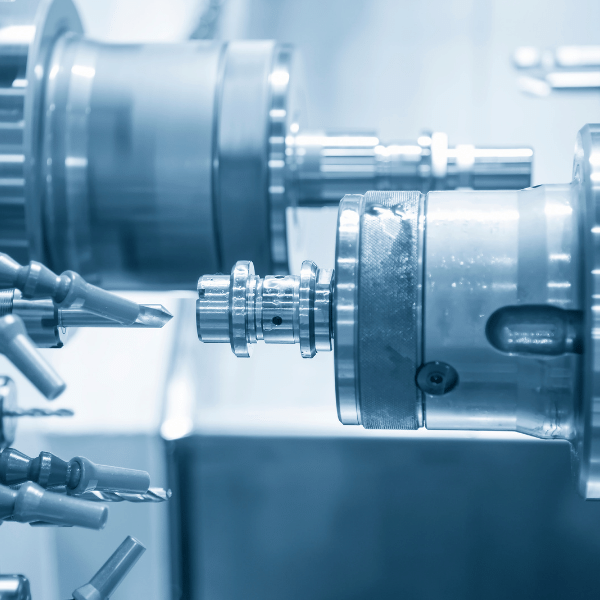Steel 1045
If you’re working with Steel 1045, make sure you have all the information you need. Visit ETCN for a complete guide to this versatile material.
Details of Steel 1045
| Alternative Names | Density | Tensile Strength | Yield Strength | Elongation at Break | Modulus of Elasticity | Poisson's Ratio | Melting Point | Thermal Conductivity | Electrical Conductivity | Post Treatments | Common Applications |
|---|---|---|---|---|---|---|---|---|---|---|---|
| AISI 1045, C45, Ck45, SAE 1045, 45# steel | 7.85 g/cm³ | 570 - 700 MPa | 330 - 450 MPa | 16 - 20% | 200 GPa | 0.3 | 1410°C | 48.2 W/(m·K) | 6.57 × 10^6 S/m | Normalizing, Annealing, Quenching, Tempering, Carburizing | Gears, Bolts, Crankshafts, Connecting rods, Studs, Axles, Hydraulic Shafts, General machinery parts |
Blogs related to CNC machining steel
Top 12 China CNC Machining Service Providers in 2023 You’ve...
For many manufacturers, CNC machining steel is crucial to producing...
Unlock the highest level of precision and longevity for machined...
CNC Machining has become an increasingly popular manufacturing solution, but...
Steel 1045 : Frequently Asked Question
• Steel 1045 is an alloy steel with a carbon content ranging between 0.45-0.55%.
• The properties of steel 1045 are sensitive to heat treatment, which allows it to be hardened and case hardened for increased strength and wear resistance.
• Steel 1045 is popular for engineering applications such as gears, shafts, axles, bolts, and studs due to its strength and ductility, moderate weldability and machinability properties.
• Compared to other steel grades in the same range (1035-1050), steel 1045 has higher tensile strength (245MPa – 510MPa) depending on the application and condition after various treatments.
• Thermal conductivity of steel 1045 can vary between 30 W/mK – 45 W/mK depending on if oil quenching process was used before additional heat treatment steps were done.
• AISI Steel 1045 is a medium-carbon alloy steel composed of 0.45-0.55% carbon, 0.60-0.90% manganese, 0.04% phosphorus, and 0.05% sulphur.
• This type of steel is heat treatable to enhance its strength, toughness and ductility.
• It has a higher carbon content and lower sulfur levels than other grades such as 1035 or 1050A for improved corrosion resistance against elements like chlorine salts or acids.
• AISI Steel 1045 offers low cost production; machinability; weldability; strength; toughness; and ductility all at an affordable price point which makes it attractive to industries with tight budgets yet need quality materials done faster than traditional methods allow.
• It has been used in various engineering applications such as agricultural equipment components, engine cylinders, machine tools and more due to its combination of properties that can withstand wear caused by repeated friction without breaking easily after few uses.
• Steel 1045 is a medium-carbon alloy steel with good strength, machinability, and weldability. Heat treatment can be used to increase its strength, ductility, and wear resistance.
• Steel 440 is a high-end stainless steel alloy with low carbon content, composed of chromium, molybdenum variations and other trace metals. It has excellent corrosion resistance and tensile strength when heat treated prior to use.
• When selecting steel for application factors such as tensile strength, corrosion resistance, durability, machinability and cost must be considered.
• We recommend using Steel 1045 for the application unless there are specific requirements that call out for the use of more durable materials like Steel 440.
• Heating steel [steel type] to 700 degrees can cause a transformation of its internal structure through recrystallization, resulting in increased hardness and toughness.
• Heat treatment can also alter the mechanical properties of metal, such as ductility, tensile strength, fatigue resistance and impact toughness.
• Depending on desired outcome, heat treatment can have varied applications such as automotive components or marine vessels.
• Safety precautions should be observed when heating steel, such as protective clothing and proper ventilation equipment.
• Carbon Steel 1045 is a medium-carbon alloy that has a carbon content between 0.45-0.55% and is widely used in the manufacturing of gears, shafts, axles and bolts due to its relatively high strength and machinability.
• Types of stainless steel include 304 and 316, which contain 18% and 16%-18% chromium respectively plus other elements such as nickel, silicon, phosphorus or sulfur.
• 316 stainless steel contains additional molybdenum for better corrosion resistance than 304 whereas stainless steel as a whole is much more resistant to rust and corrosion compared to carbon steels like 1045.
• The Modulus of Resilience (Elastic Modulus) is a measure of a material’s ability to absorb energy before deforming or breaking.
• It provides an indication of a material’s toughness or resistance to impact, which is important for applications with shock loading and vibration.
• Soft metals with low yield strengths but high moduli of resilience can perform better if used.
• Knowing the modulus of resilience helps determine which material is best suited for an application, as higher values indicate higher resistance and shock absorption capacity.
• It is also useful in predicting fatigue failure due to cyclic loading, making it suitable for components used in products subjected to repeated cycles over long periods.
• Carburizing is a process of introducing carbon into the surface of steel, increasing its hardness and strength.
• Necessary equipment includes an oven/furnace, material handler and safety gear.
• Gas and pack carburization are the most common methods, each with its own advantages and disadvantages.
• The process involves preparing the workpiece, heating it at temperatures above 1,400°F (760°C) in an oven/furnace with either gas or pack introduced, followed by quenching and tempering.
• The result is case-hardened steel with increased depth of hardening layer and greater wear resistance than conventional steels.



